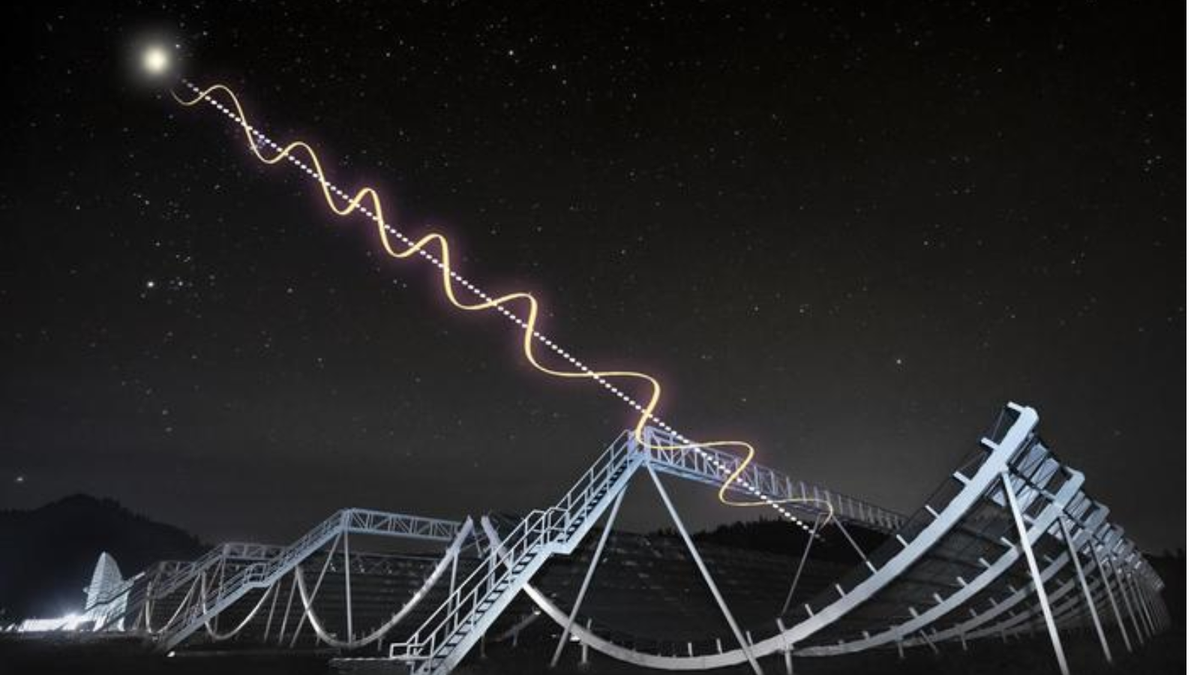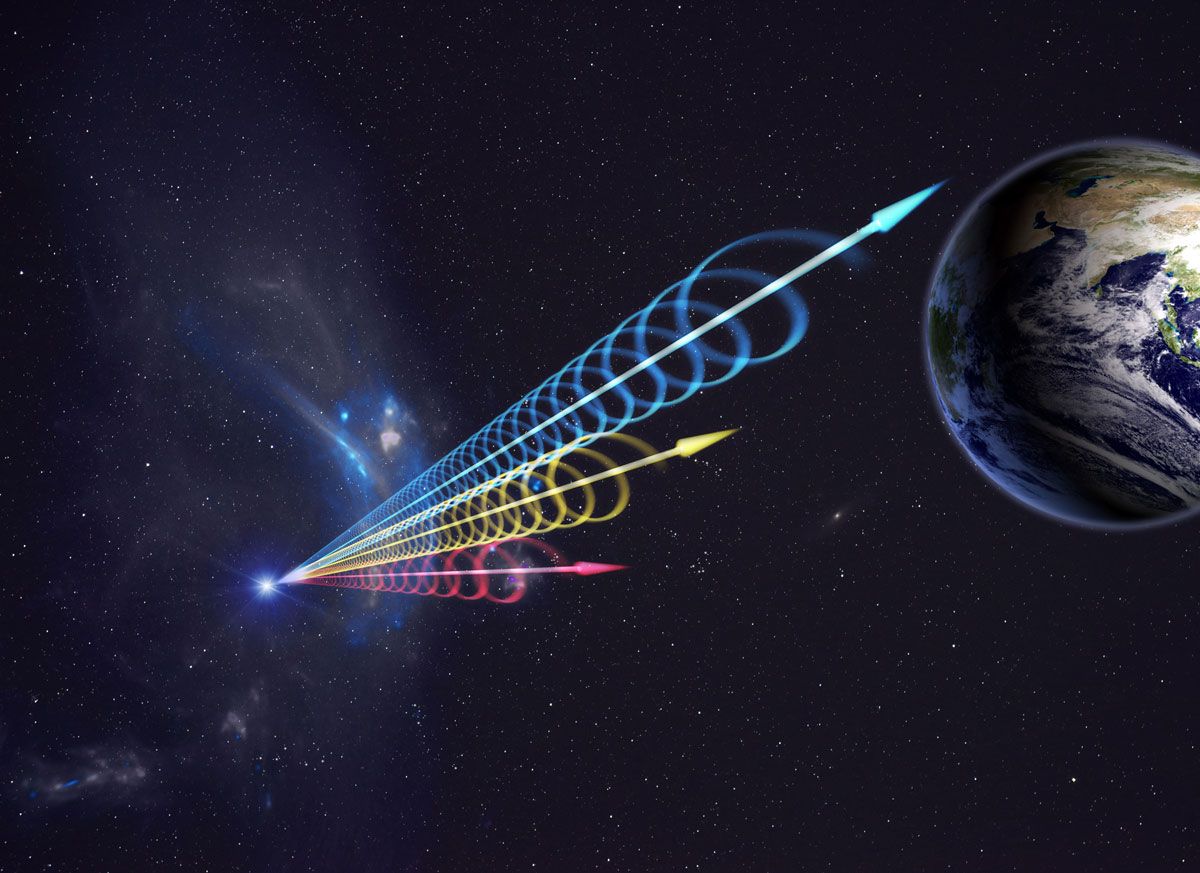Fast radio bursts (FRBs) are intense, short-lived bursts of radio waves coming from beyond the Milky Way that can release the same amount of energy in just milliseconds that it takes the sun three days to emit.
However, despite their power and the fact that as many as 10,000 FRBs can explode in the sky above Earth every day, these radio bursts remain mysterious. One of the biggest puzzles surrounding FRBs is why most flash once and then disappear while a tiny minority (less than 3 percent) repeat the flash. This has led scientists on a quest to discover the mechanisms that emit FRBs. Some even believe that different celestial objects can produce repeating and non-repeating FRBs.
Scientists from the University of Toronto used the Canadian Hydrogen Intensity Mapping Experiment (CHIME) to focus on the properties of polarized light associated with 128 non-repeating FRBs. This revealed that single FRBs appear to originate in distant galaxies that are much like our own Milky Way, as opposed to the extreme environments that emit their repulsive cousins. The results may bring scientists closer to finally cracking the ongoing celestial puzzle of FRBs.
Connected: Hubble telescope finds surprising source of fastest radio burst ever
“Until now, when we’ve thought about FRBs, we’ve only looked at them in the same way that we would look at a star in the sky, thinking about how bright it is, maybe figuring out how far away it is, things like such,” lead research author Ayush Pandhi, a Ph.D. student at the Dunlap Institute for Astronomy and Astrophysics and the David A. Dunlap Department of Astronomy and Astrophysics at the University of Toronto, told Space.com. “However, FRBs are special because they also emit polarized light, meaning that the light coming from these sources is all oriented in one direction.”
The main difference about this research is that it is really drilled into the investigation of polarized light.
Polarized light consists of waves that are oriented in the same way – vertically, horizontally, or at an angle between these two directions. The changes in polarization could explain the mechanism that started the FRB and thus reveal what its source was. Polarization can also reveal details about the environments the FRB had to traverse before reaching our detectors on Earth. This study represented the first large-scale look at the 97% non-repetitive FRBs in polarized light.
There has been a gap in the search for non-repeating FRBs because it is much easier to observe repeating FRBs as astronomers already know where they will occur, meaning it is possible to point any radio telescope at that part of the sky and wait. With non-repeating FRBs, astronomers must have a telescope that can look at a large area of the sky at once, because they don’t really know where the signal will come from.
“They can appear anywhere in the sky. CHIME is unique in that sense because it looks at such a large part of the sky at once,” Pandhi said. “Also, people haven’t seen that polarization yet because it’s much harder to detect just on a technical level.
“Other studies have looked at the polarization of maybe 10 non-repeating FRBs, but this is the first time we’ve seen more than 100. This allows us to reexamine what we think FRBs are and see how many repetitive and non-repetitive FRBs can be different.”
To repeat or not to repeat?
In 2007, astronomers Duncan Lorimer and David Narkevic, who was Lorimer’s student at the time, discovered the first FRB. It was an unrepeatable burst of energy now commonly referred to as the Lorimer Burst. Five years after that, in 2012, astronomers discovered the first repeating FRB: FRB 121102. After that, more repeating bursts were gradually detected.
Astronomers naturally wonder if there is a different phenomenon behind these two types of FRBs. And Pandhi’s team did find that non-repeating FRBs appear to be a bit different from repeating FRBs, as most of the former appear to come from galaxies like our own Milky Way.

While the origins of FRBs are shrouded in mystery, these bursts of radio waves can act as harbingers of the environments they pass through on their race to Earth. This information is encoded in their polarization.
“If polarized light passes through electrons and magnetic fields, the angle at which it is polarized rotates, and we can measure that rotation,” Pandhi said. “So if an FRB passes through more material, it will rotate more. If it passes through less, it will spin less.”
The fact that the polarization of non-repeating FRBs is smaller than that of repeating FRBs indicates that the former appear to pass through less material or weaker magnetic fields than the latter. Pandhi added that, while repeating bursts of radiation seem to come from more extreme environments (like the remnants of stars that have died in supernova explosions), their non-repeating brethren seem to emerge in slightly less violent environments.
“Non-repeating FRBs tend to come from environments that have either weaker magnetic fields or less stuff around them than repeating FRBs,” Pandhi continued. “So the recurrence of FRBs seems to be a bit more extreme in that sense.”

Are neutron stars off the hook?
One of the big surprises this research gave Pandhi was that the polarization of non-repeating FRBs appears to clear up one of the main suspects behind their release: highly magnetized, rapidly rotating neutron stars, or “pulsars.”
“We know how pulsars work, and we know the kinds of polarized light we expect to see from a pulsar system. Surprisingly, we don’t see that many similarities between FRBs and pulsar light,” Pandhi said. “If these things come from the same kind of object, you might expect them to have some similarities, but it turns out they’re actually very different.”
As for detecting objects that emit FRBs, Pandhi thinks that expanding our understanding of the polarization of these radio bursts could help narrow down theoretical predictions.
“If we’re confused between many different theories, we can now look at polarized light and say, ‘Okay, well, does this rule out any theory that we haven’t already ruled out?'” he said. “It provides a another parameter, or even some additional parameters, to help us rule out theories of what they might be until we have one that sticks.”
Pandhi went on to explain that this study laid the groundwork for future FRB investigations; he himself is working on a way to disentangle the polarization of FRBs that occurred in the Milky Way from those that occurred in their other galaxies and closer to the source of their emission.
This should help us better understand the mechanisms behind the release of FRBs, but for Pandhi, it’s the mysterious nature of these cosmic bursts of energy that ensures he’ll be investigating them for some time to come.
“I mean, what’s more mysterious than explosions happening thousands of times a day all over the sky, and you have no idea what causes them?” said Pandhi. “If you’re a bit of a detective who likes to solve mysteries, the FRBs are just a mystery just begging to be solved.”
The team’s research was published Tuesday (June 11) in the Astrophysical Journal.